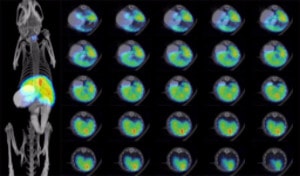CT26.WT Cells
Products
CT26.WT-eGFP-Puro $ 1,500
CT26.WT-Fluc-Neo/eGFP-Puro $ 2,100
CT26.WT-mNIS-Neo/eGFP-Puro $ 2,100


Description:
Usage Information:
CT26.WT cells are suitable for in vitro and in vivo experimentation. Both syngenic BALB/c mice and immunocompromised mice can be used for in life studies, and will form tumors following implantation of the cells.
The following chart provides some examples of CT26.WT cells used for tumor formation and studies.
|
Route of Implantation |
Mice |
Tumor/Metastases |
References |
|---|---|---|---|
|
Intrasplenic |
BALB/c |
Liver metastases |
Jiao et al. (2014) J Biomed Sci 21: 1. Mi et al. (2006) J Surg Res 131: 97-104. |
|
Subcutaneous |
BALB/c |
Subcutaneous tumor |
Wang et al. (1995) J Immunol 154: 4685-4692. |
|
Tail vein |
BALB/c |
Lung metastases |
Wang et al. (1995) J Immunol 154: 4685-4692. Kim et al. (2014) Biochem Pharm 92: 251-265. Gou et al. (2014) PLoS One 9: e85789 |
|
Intraperitoneal |
BALB/c |
Peritoneal tumor metastases |
Gou et al. (2014) PLoS One 9: e85789. Ryan et al. (2015) Oncogene 34: 1563-1574. |
Note: The above information is based on available data from the indicated references. It is not meant to be comprehensive and Imanis has not directly tested each condition.
Stable reporter cell lines:
Our CT26.WT reporter cell lines can be tracked in vivo, making them great tools for studying the mechanisms of tumor growth and metastasis, as well as evaluating the effects of various drugs or therapies in animals. Our CT26.WT cells are available with a variety of different reporters, including the murine sodium iodide symporter (mNIS), firefly luciferase (Fluc), enhanced green fluorescent protein (eGFP), or near-infrared fluorescent protein (iRFP). Several dual reporter CT26.WT cell lines are available to facilitate multi-modality imaging.
In order to ensure high, constitutive expression of the reporter proteins, our cell lines are generated by lentivirus transduction. The lentivirus vectors used for these transductions are self-inactivating (SIN) vectors in which the viral enhancer and promoter has been deleted. This increases the biosafety of the lentiviruses by preventing mobilization of replication competent viruses (Miyoshi et al., J Virol. 1998).
For more information about a specific reporter and its uses, click on the photos below.





